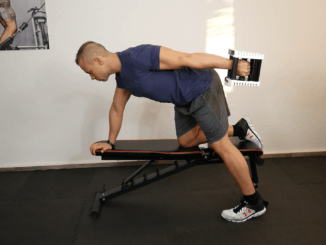The musculus triceps brachii, also known as the triceps, is an important muscle on the back of your upper arm. It has three heads, which is also reflected in its name: “tri” means “three-”, “ceps” means “heads” and “brachii” comes from “brachium” or “brachion”, which means arm or upper arm. The name of the muscle comes mostly from Latin, except for “brachion”, which comes from Greek (1). But enough about the name, let’s take a closer look at the triceps! In this article you will learn everything about the origins, insertions, functions, and peculiarities of this fascinating muscle.
Musculus triceps brachii – Origin and insertion
The musculus triceps brachii runs over two joints: the shoulder joint and the elbow joint. The three heads of the triceps originate at different places on your upper arm bone and your shoulder blade. The medial head, also called caput mediale, originates on the posterior part of the upper arm bone below the spiral crest. The lateral head, also called caput laterale, originates on the posterior part of the upper arm bone above the spiral crest. The long head, also called caput longum, originates on the tuberculum infraglenoidale, a small elevation below the socket of the shoulder blade (1,2).

The muscle has three parts that are separated by a groove on the upper arm bone. The longest part (caput longum) comes from the shoulder blade, the lateral (caput laterale) and medial part (caput mediale) from the upper arm bone. The tendon of the muscle attaches to the elbow process of the forearm bone. The longest part of the muscle has a tendinous origin on the tuberculum infraglenoidale and on the labrum glenoidale of the scapula. It passes into the lower shoulder joint capsule. It is the closest to the body of the three heads and its fibers connect with the caput mediale to form a tendon. It runs down in front of the M. teres minor and behind the M. teres major. The lateral part has a muscular origin on the posterior side of the upper arm, above and outside of the sulcus nervi radialis, between the attachments of the M. teres minor and the M. deltoideus. Its fibers cross the sulcus nervi radialis to join with the inner head. This creates a bony-fibrous canal in which the N. radialis is protected as it pulls down. The large, muscular medial part lies deep between the other two heads. It originates on the back of the upper arm, below and inside of the sulcus nervi radialis, up to the fossa olecrani. It also originates on the back of the septa intermuscularia mediale and laterale. From the three heads emerges a broad common, two-layered tendon whose upper layer covers the lower posterior part of the muscle while the lower layer originates in the muscle itself. This special structure increases the attachment area for the muscle fibers. Both layers become a tendon that attaches to the back of the olecranon (often called “elbow hook” in German) and radiates into the deep forearm fascia on both sides (1, 2, 3). Some muscle fibers of the medial part attach themselves from behind to the joint capsule of the elbow and prevent its pinching during complete extension movements (3).
Musculus triceps brachii – Innervation
The radial nerve from the posterior fasciculus (nerve fiber bundle in the area of the brachial plexus) of the brachial plexus supplies all three muscle parts of the M. triceps brachii with their own branches. The branch to the lateral head has its origin in segments C6, C7, and C8, while the branches to the long head and medial head come from segments C7 and C8 (3).
The M. triceps brachii is the key muscle for the spinal cord segment C7, as it is mainly innervated by this segment. This means that the nerve fibers that control this muscle exit from the seventh cervical vertebra (2).
Musculus triceps brachii – Functions
The M. triceps brachii is the most important extensor of the elbow joint. It consists of three heads: medial head, lateral head, and long head. The first two act only on the elbow joint, while the long head additionally participates in the retroversion (backward movement) and adduction (pulling the arm towards the center of the body) of the arm in the shoulder joint and also separates the lateral and medial axillary opening from each other (1, 2, 3).
If you want to learn more about the anatomy and function of the muscles, feel free to check out other articles on my blog, such as the anatomy of the Adductors. I appreciate your feedback and questions in the comments. You may also find interesting videos on fitness & co on my YouTube channel.
References
1. Sobotta, J. (2017). Sobotta, Atlas der Anatomie Band 1: Allgemeine Anatomie und Bewegungsapparat. Deutschland: Urban & Fischer in Elsevier.
2. Waschke, J., Böckers, T. M., & Paulsen, F. (Eds.). (2019). Sobotta Lehrbuch Anatomie. Elsevier Health Sciences.
3. Palastanga, N., & Soames, R. (2014). Anatomie und menschliche Bewegung: Strukturen und Funktionen. Elsevier, Urban&FischerVerlag.

Be the first to comment